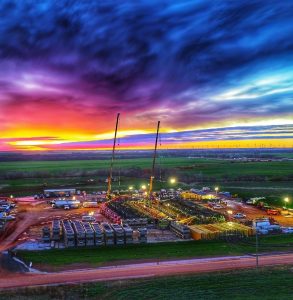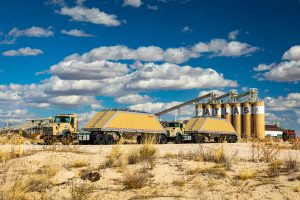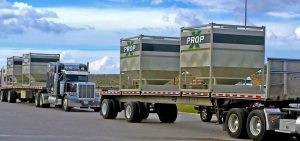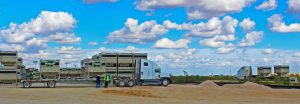“In most cases the largest cost component of frac sand for wells is the delivery cost,” said Bud Brigham, executive chairman and CEO of Atlas Energy Solutions, in an email interview. Atlas’s goal is “to get the trucks off the public roads” for safety, efficiency, and the environment. Those are similar to the goals of last-mile company PropX’s President and CEO, Kevin Fisher. Increasing speed of delivery and reducing transportation costs are the other driving factors in developing new delivery systems.
Those issues go a long way toward explaining the push that began about six years ago to migrate away from railroading frac sand hundreds of miles from Wisconsin. The progression led to sourcing sand from near Brady in central Texas then on to tapping the sand dunes around Kermit and Monahans. Finally, in the last two or three years, some companies started accessing proppant at distances ranging from immediately onsite to a few miles away. And some are further reducing costs by using wet sand instead of spending time and energy in the drying process.
Tightening the Belt
One of the most efficient delivery options would be Atlas’s DuneExpress new conveyor delivery system. Stretching 42 miles westward from the company’s Kermit mine and terminating in New Mexico—with load-out stations at the state line and at the end—the line “is intended to eliminate millions of truck miles driven across the Permian” in order to boost road safety, says the company’s website.
Brigham explained his thinking this way: “The current situation in the Permian, particularly given the accidents and fatalities due to trucking on commercial roadways, is unacceptable, and we are determined to change that. As someone who grew up in Midland, I take this challenge very personally.”
In addition to boosting safety, the DuneExpress and related logistics systems are designed to greatly increase last-mile efficiencies.
Because Brigham and his associates started in the industry as operators, he feels they have deep insight into frac sand’s end use and how to make that supply chain work. “Whether we were operating in the Bakken, or in the Permian, we recognized that moving commodities around via trucking, whether it’s oil, gas, water or now sand, is a terrible way to move product,” he said.
He added that conveyor systems have been used for decades in all types of industries around the world. “It is the preferred method for transporting bulk materials in other industries, due to the low transportation cost and increased safety, and it’s proven so in much harsher and more difficult terrains and environments, and with more challenging materials.” They have already employed about five miles of conveyors internally in their two plants, with excellent results.
Brigham noted that the range and positioning of Atlas’s sand resources made the conveyor system viable uniquely for them. “Given our premier position on the two giant open dunes at Kermit and Monahans, we benefit not only from our logistical initiatives, but also uniquely from an associated freshwater aquifer just a few feet beneath the surface. As a result, we are transitioning to electrified dredge mining, which will substantially reduce our need for heavy equipment and personnel, further optimizing our cost structure, while also substantially driving down emissions. No other sand provider in the Permian Basin benefits from dredge mining, providing us with additional cost and environmental advantages, further enhancing our differentiated sustainability.”
He notes that those dunes allow the company to “control over a century of resource,” a fact that allows them to plan and execute large-scale logistics, including DuneExpress.
This means that mining sand is only one aspect of Atlas’s business model. “We… are not just a proppant producer, we are increasingly a logistics company, and we are incorporating, with the DuneExpress, midstream components, providing us with exciting avenues for growth. As our logistical initiatives expand, we therefore have a very special opportunity to accelerate the transformation of the Permian into a more efficient factory on the ground.”
He reported that the company has also partnered with a “provider of autonomy and robotic technology with experience in GPS-denied off-road autonomous solutions and expect to begin testing in the field this year with the goal of developing this technology over time to further enhance efficiencies and reliability….”
GPS-denied solutions are helpful near buildings, under trees, near radio tower interference, and in other places where satellite-based navigation is disrupted.
PropX Containers Speed Sand Logistics
Speeding the loading and unloading of trucks that are on the road is the goal of PropX. This company, whose familiar name is short for its longer appellation—Proppant Express Solutions, LLC—provides containers and conveyor belts for customer use in transporting and deploying frac sand. PropX has 13,000-plus company-owned containers, which they lease out on one-to-five-year terms. Customer categories cover the gamut of the frac industry, said Fisher. “We have E&P companies as customers, we have frac companies, we have sand mining companies, [and] we have truckers and logistics companies.”
Their containers are made to hold up to 30,000 pounds of sand, riding by twos on a flatbed trailer. In Texas, he said, the gross vehicle weight (GVW) limit for interstate and state highways is 82,000 lb., including the payload, the tractor, the boxes, and the trailer. On Farm-to-Market roads and other side roads the limit can be 84,000 lb. In some states, such as Colorado and Oklahoma, the limits are as high as 92,000 lbs., he said.
That leaves room, in Texas, for about 24,000 lbs. of sand per container, per trip. Fisher said they designed the boxes to be large enough to haul the limit in any state and to accommodate any GVW of tractor or trailer.
It takes about 10 minutes to load the boxes at a mine or transit facility. Then, upon arriving at the well site, a forklift picks up the boxes from the trailer and stacks them with other sand inventory. Next, the forklift reloads the trailer with two empty boxes, an operation which takes about 7-10 minutes. Empty are transported back to the mine or transit facility for reloading, completing the loop.
Fisher said this loading and unloading speed is a major advancement over previous procedures. Older methods required 45 minutes to unload sand from the pneumatic trailer at the site. That trailer would blow the sand off into receiving machinery at the well site. With the boxes, trucks are more efficient—each one unloads quickly, and there is no long line of others idling behind them. Plus, more sand can be delivered per hour.
Overall, frac crews rarely run out of sand under this scenario, because most sites have room for about two stages’ worth on hand, and deliveries can come quickly if they start to run short.
Frac Speed Pushes Faster Delivery Logistics
 Breakneck frac speeds are the norm these days, said Fisher, both in delivery and in pumping. For example, “Six or eight years ago, a really good frac crew with a really good sand delivery system could pump 2-3 million pounds of sand a day—and you would hear, occasionally, that one crew pumped 4 million pounds,” he recalled. That was a major exception.
Breakneck frac speeds are the norm these days, said Fisher, both in delivery and in pumping. For example, “Six or eight years ago, a really good frac crew with a really good sand delivery system could pump 2-3 million pounds of sand a day—and you would hear, occasionally, that one crew pumped 4 million pounds,” he recalled. That was a major exception.
“Today, they average about 4 million pounds. And the better crews are doing 5-6-7-8 [million]. We’ve had crews run 12-plus million pounds of sand in a day.” The latter amounts to 250 truckloads, as opposed to the 80 truckloads involved at the 4-million-pound level. “You could never have done that when it took 45 minutes to blow off one truckload of sand,” he said.
Cost vs. Quality
As noted by Bud Brigham, producers are intent on reducing transportation costs, which in the past were the main expenses in frac sand. The move to local sand has led to other changes, however, in Fisher’s estimation, as he sees a cost-and-quality-related progression.
“Sand has successively gotten to be lower quality,” he said, recalling the days of ceramic proppants about 10 years ago. Ceramics “were man-made, they were hard, they were smooth, a clean round, and they were large—20/40 or 16/30.” The industry thought those properties were necessary, even though the proppants were very expensive.
“Then you moved to white sands from Wisconsin. It’s smaller, it’s not as strong, it’s not quite as round or as smooth, so it doesn’t have quite the conductivity” of ceramics. “It was much cheaper than ceramics. So you’d just pump more white sand” to achieve the same frac results.
Brown sand came next, so colored because it’s laden with impurities that make it softer, irregularly shaped, and less conductive in the formation. It doesn’t work as well, but it’s cheaper. “So you compensate; the sand’s half the price, you go pump 30 percent more sand to make the same kind of well,” he explained.
Wet Sand
The move toward wet sand is still new, but, as Fisher says, combining it with mobile, on-site mines offers some advantages and some challenges. “Mobile mines are 100 percent wet sand. It cuts their capital costs in half by not adding dryers.” Without dryers, permitting is easier because air quality permits are deemed unnecessary—wet sand does not become airborne like dry sand does—and without a kiln to dry the sand, there’s no need to access natural gas onsite, he said. Being located onsite means transportation costs basically drop to zero.
Some adaptation in the delivery system is necessary to accommodate its different flow properties. Fisher said about 16 of the company’s 70 frac supply systems are currently running with wet sand. While about half of that comes from mobile mines, the rest is delivered from fixed sources. Wet sand is sticky—it doesn’t flow like dry sand does—so PropX had to modify its equipment. Augurs that bring up dry sand don’t work.
For wet sand, software-controlled inputs deliver water and chemicals directly into the blender, instead of just lifting the sand out and mixing it and all the frac components as they travel to the well. The challenge is that that system requires a vibration mechanism to loosen the sand so it flows at all.
A new wrinkle on that procedure, named Sand Scorpion, uses an automated system to raise and tip the box over to dump the sand out of the top instead of pulling from the bottom, eliminating the need for vibration.
From the outside it might seem that mining sand and running it downhole would not invoke great inventiveness. Instead, as is apparent from all of the above, it is a creative logician’s paradise, spawning new innovations around every aspect of the operation.
By Paul Wiseman












